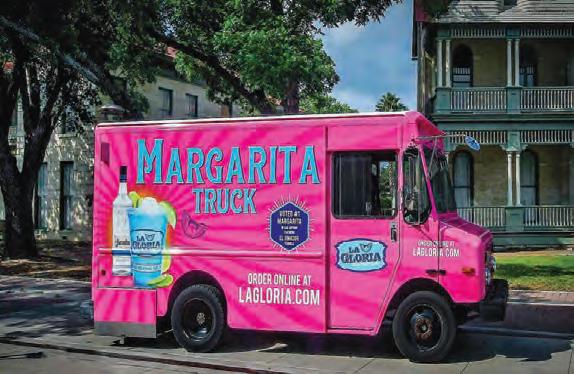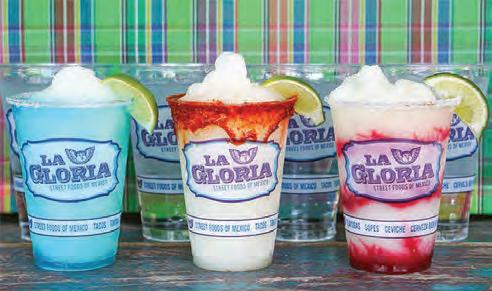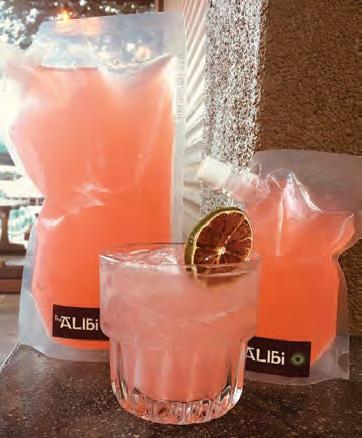
10 minute read
AT THE BAR—Good to Go
Good to Go!
RESTAURANTS BOOST SAGGING SALES WITH COCKTAILS TO GO
| BY ELYSE GLICKMAN | The “new normal” is now an everyday reality—and restaurateurs and bar owners are doing everything they can to survive the current crisis and the uncertain business climate that lies ahead.
One new trend they’re tapping: Portable potables in the form of to-go cocktails and cocktail kits, which are helping them connect with customers while keeping profits flowing during these socially distanced times.
“We’re always paying atten tion to our guests’ feedback to help us grow in these uncer tain times,” says Michael Huber , managing par tner of Lanea, a popular tacocentric spot in Santa Monica, California. “We’re experi menting constantly with new drink offerings and flavors, like our new frozen Cata lina Wine Mixer, made with gin, Lillet, fresh lemon and orange liqueur. (We’re dealing with) a whole new industry, and we’re excited to work and make sure we’re giving customers the best version of the restaurant as they knew it pre-pandemic.”
Lanea’s Picnic Pack: 2 cocktails plus blanket
PHOTO BY @JENKAY (IG)
RELAXED LIQUOR LAWS One adjustment that’s made that “new normal” easier to swallow is the easing of local liquor laws, which enables bar tenders to keep their creative juices flowing and of fers owners and managers additional incentive to keep their doors open for limited ser vice.
What restaurants and bars can and can’t do varies by state and city. And wherever to-go cocktails have the green light, the “relaxed” liquor laws are still pretty strict.
Some stipulate to-go cock tails can only be sold with a food purchase fr om the same establishment; others require that the cocktails come in containers with a secure lid or cap. In most places, there are strict “last call” closing times and delivery hours that limit service. And in some

Lanea’s cold pack cocktails jurisdictions, a mandated maximum of 2.25 liters per consumer per day applies.
Even with these localized laundry lists of rules, myriad restaurants are rising to the occasion with cocktails-to-go programs that embrace social distancing and social respon sibility, too.
READY, SET, POUR! Whether they’re taking the pre-mixed route with individual and pitcher-sized readyto-drink cocktails, of fering cocktail-making kits, or some combination of the two, the savviest establishments are getting creative with recipes, packaging and promotions behind the bar.
LANEA. Lanea offers a selection of house best-sellers, from their Mar garitas and Palomas to originals such as the Oaxacan Mule, the Third Street Sling, Catalina Wine Mixer and Jungle Bird Scoot er. Although many L.A.-ar ea restaurants are offering DIY kits, Huber say his custom ers were “too busy making banana bread and lear ning to knit to be bothered with mak
Lanea’s to-go Paloma

ing their own cocktails.”
Lanea’s best sellers maintain a hand-crafted sensibility, fr om the basic Mar garita made with Cazadores Tequila, fresh lime, Demerara and orange liqueur to the spicy Mar garita made with Jaja Tequila, fresh lime and house-made habaner o honey to the highconcept “Watermelon.Sugar. “To ensure freshness and efficiency, we have our bartenders make a fresh batch of Margaritas-to-go daily. We also added a ‘perishable’ label on the bottle that reminds customers the cocktail needs to be refrigerated and consumed immediately.”
– MICHAEL GAINES, Xperience Restaurant Group High” made with Bacardi rum, Strega, fresh watermelon juice and lime.
Instead of going the popular glass container route, Lanea’s to-go drinks are sold in a can or cold pack format. The pack aging is not only sustainable and eco-friendly but also has “curb appeal” and is easier to manage if customers bring lunch or dinner to the beach or the park, Huber explains.
T o mix things up, manage ment is also looking into packaging premium tequila and mezcal tasting flights for customers who want a less sweet and more conversational way to appreciate what Lanea offers during better times.
Huber felt it was appr opri ate to offer customers a value pr oposition, discounting individual cocktails in defer ence to customers af fected by cur rent economic conditions. Drink prices also go down when customers order a 4-, 6- or 12-pack of cocktails. Even with reduced prices, Huber stresses customers can expect Lanea’s same high-quality standards and emphasis on freshness.
“We try to use as many fresh ingredients as pos sible, and only acid modify when necessar y. All our ingredients are hand-selected and tested based on absolute freshness, with the drink’s lifespan in mind,” Huber explains. “Additionally, our use of pressure with nitrogen and CO2 in our state-of-the
The Margarita Road Show

In San Antonio, La Gloria has stretched the “Margaritas-to-go” concept by bringing their award-winning Margaritas to fans via one of two festively decorated ice cream trucks that cover different areas of the city on different days. The trucks make home deliveries, too.
The Margarita selection is impressive: House, Blue, Prickly Pear and Mango, all in a choice of frozen or on the rocks. There are even make-your-own cocktail packs (House Margarita, Los Pepinos Cucumber VodkaRita, Las Fresas Margarita and Jack & Coke) for those who prefer DIY libations. A limited food menu that includes taco kits, chips, salsa and queso is also available.
The truck has generated so much interest that La Gloria’s management recommends that customers watch for updates on La Gloria’s social media accounts because there have been

days that customized delivery options were sold out due to the overwhelming response.
“Our Margarita trucks are another fun, creative way to adapt in an ever-changing restaurant business landscape where safety is top of mind,” says Chef Johnny Hernandez, founder and president of parent company Grupo La Gloria and True Flavors Inc. “While we know many of our customers are not ready to dine out, we know that doesn’t mean they don’t crave one of our famous Margaritas. Delivering to our customers’ homes not only makes enjoying our signature Margaritas safer and more convenient, but this new avenue of serving our customers also helps us rebuild our business and ultimately will allow us to hire back more members of our team.”
Customers can follow the trucks’ whereabouts at facebook.com/ lagloriamargaritas and pre-order their cocktails at LaGloria.com.




Limón’s to-go cocktails

art canning system helps extend that freshness, so the customer’s experience once they crack open their cocktail is as if they’ve had one of our expert bartenders right there, making the fresh drinks with them all night.”
XPERIENCE RESTAURANT
GROUP, Los Angeles. With Sol Cocina, Pink Taco, El Torito, Chevy’s and Las Brisas in its family of restaurants, Xperi ence Restaurant Group decided being straight forward and uncomplicated was the way to go when developing a cocktails-to-go program.
“We are choosing to-go cocktails instead of kits be cause it ensures consistency in the quality of our cocktails and makes the customer experience easier—they just have to shake and pour over ice,” explains Michael Gaines, the company’ s food and beverage director, who says Xperience kept the selection of to-go cocktails to its topselling Margaritas and bottled them. “Just like we observed with our dine-in situation, guests are mostly demanding classic Margaritas like our House Margarita and Cadillac Margarita, and at some of our brands, true breakout hits like the Watermelon Margarita,” he adds.
No changes were made to its existing cocktail recipes and glass containers—which he says are “sturdy, re-sealable and recyclable”—are the vessels of choice. “To ensure freshness and efficiency, we have our bartenders make a fresh batch of Margaritas-to-go daily,” he says. “We also added a ‘perishable’ label on the bottle that reminds custom ers the cocktail needs to be refrigerated and consumed immediately.”

CASA VEGA, Los Angeles. Christy Vega, owner of this 64-yearold LA landmark, found that the classics needed to stay front and center when she streamlined the bar menu for a cocktails-to-go program.
“As long as we have Mar garitas flowing, our customers are happy,” says Vega, who r epor ts the biggest seller has been the ½-gallon size of Casa Vega’s Classic Mar garitas for $30, which makes eight individual cocktails.
“Ther e are no changes to our recipes. We are still using fresh-squeezed juices and the highest quality ingredients,” she says. “The only modifica tion we made was packaging the to-go cocktail in a 16-oz. mason jar . For single serv ing margaritas, I prefer glass mason jars as, in my opinion, alcohol does not taste right in plastic.”

LIMÓN, San Francisco. Cocktailto-go customers at this Northern California Peruvian restaurant lean toward pisco sours, sangria, maracuya sours and Margaritas, ac cording to owner Antonio Castillo. Unlike V ega, Castillo is a fan of plastic containers. “Our plastic jars are working great for us because they seal nicely and are less likely to be broken or damaged during transport,” Castillo reports.
THE ALIBI, Palm Springs, California. Fussy drinks and made-toorder cocktails are out, while “sentimental classics” are in, according to co-owner Melanie Tusquellas. “Cus tomers want to have stability and familiarity in drink choices during these challenging times. Our pre-made cocktails were selected with historical knowledge of what were simple best-sellers pr epandemic and what would be suitable for an ease of service at home without a profes sional bartender,” Tusquellas explains. “We want the take-home cocktail to be as r eliable and delicious as the same drink you order from your favorite bartender at The Alibi. Customers seem to prefer ease and simplicity, so ready-to-serve cocktails are preferable and from a manager perspective they can be more consistent with less waste.”

The Alibi’s Watermelon Daiquiri
Tusquellas says each takehome cocktail (Mar garitas, watermelon daiquiris and palomas are most popular) comes in a sealed container and is created to have a shelf life of seven days. “We do not use fragile garnishes, highly perishable herbs or fussy juice mixes,” she says, noting fresh-squeezed juices deliver a higher quality taste and travel better than complex delicate herbal mixes. “We aim for a pure, simple, classic mix that is refrigerated and ready to pour after a simple shaking in the to-go container.”
To-Go Not Always a Go
Not every restaurant el Restaurante reached out to was effusive about the cocktail-to-go format.
At Peruvian-inspired Rosatoro Restaurant & Pisco Bar in Queens, New York, general manager Kevin Sales recently put his to-go cocktail menu on hold to take time to weigh the pros and cons of the program.
“We were offering some of our house and classic cocktails, including flavored Margaritas, mojitos and piña coladas, leaning toward fresh summer flavors,” Sales says. “The pricing was around $12 to $20, based on size, and offered in 12-, 16- and 32-oz plastic bottles.”
What made Sales pull back, at least for a while?
“While pre-made cocktails sell well because customers do not need to take any extra steps to complete them, I worry about taste and consistency not quite matching up between on-premise and to-go versions,” he says, “even if citric acid can be added to preserve flavor.”
How will customers react to the cocktails they’re getting to go? And what are you doing to maintain quality, flavor and consistency of what you’re offering? Those are important things to consider as you’re planning and implementing your cocktails-to-go menu—because the goal, after all, is to maintain and build your reputation during the current crisis so guests will flock back when the pandemic subsides.










